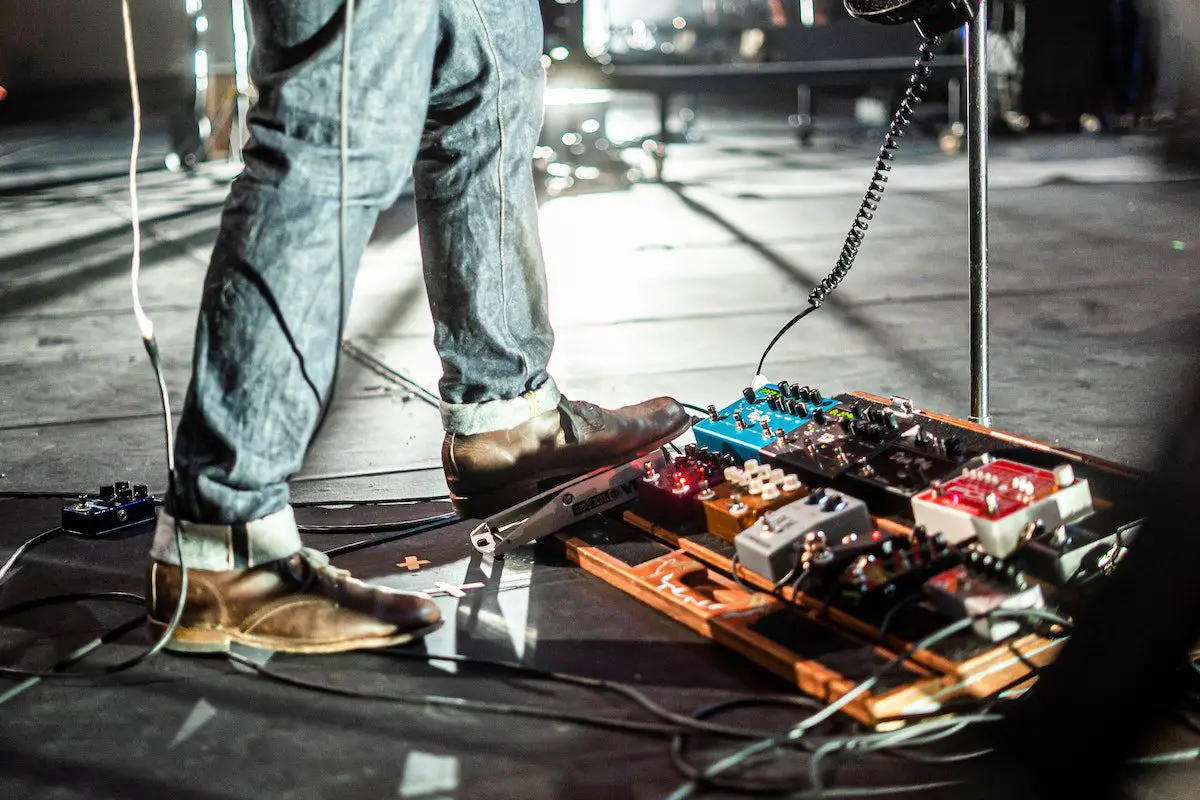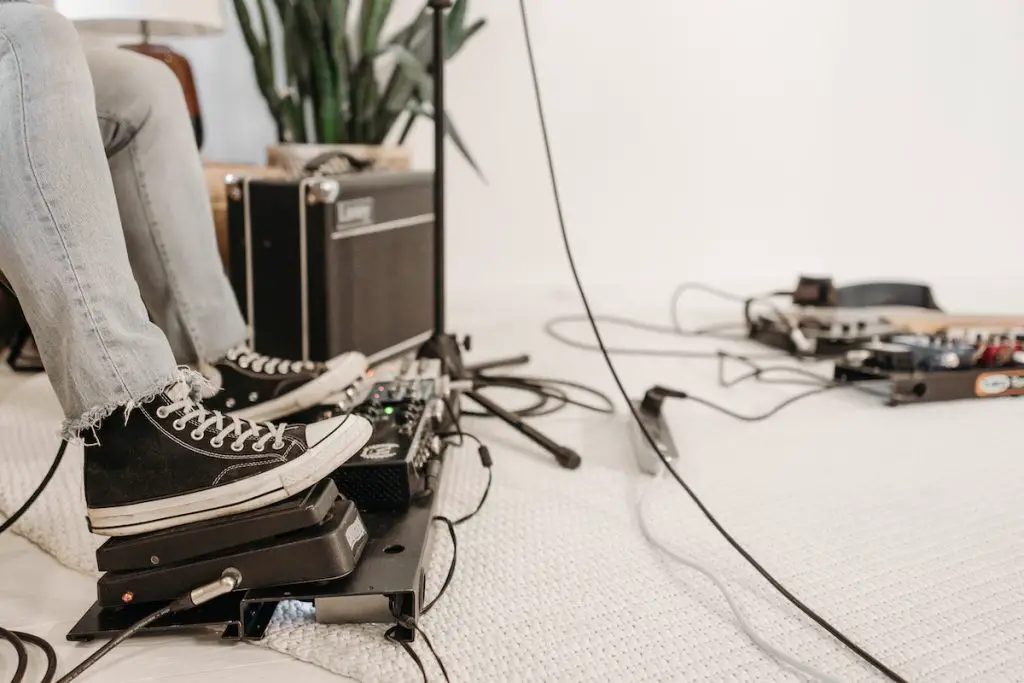Do you ever feel your music is missing that extra “oomph”? Maybe you’re looking to add more emotion and depth to your sound. Well, look no further! Expression pedals are the key to unlocking your guitar’s full potential. In this blog post, we’ll dive into what an expression pedal in audio is, how it works, and why it’s the secret ingredient to spice up your tunes.
No more confusion between expression, volume, and wah pedals! We’ll break it all down, and you’ll finally understand the differences and applications of each type. So, are you ready to put the “express” in the expression pedal? Let’s dive in and make your guitar “speak” like never before!
What is an expression pedal? An expression pedal is a versatile tool used by musicians to control various parameters of their audio equipment, such as effect intensity or modulation. By adjusting the pedal with their foot, musicians can create dynamic and expressive performances.
What is an expression pedal?

AKAI Professional MPK Mini MK3

AKAI Professional MPK Mini MK3
How do expression pedals work?
Expression pedals work by using a continuous-action, foot-operated mechanism to remotely control various parameters of electronic music equipment such as digital amplifiers, rack effects, stompboxes, MIDI controllers, and keyboards. They do not directly contribute to the sound but alter aspects of the connected device, such as volume, wah-wah, pitch, modulation, delay level, and reverb amount.
…the most common type of pedal contains a simple potentiometer, mechanically linked to the pedal mechanism and electrically connected to the synthesizer or other audio equipment…
There are a few different methods that expression pedal manufacturers use, but the most common type of pedal contains a simple potentiometer, mechanically linked to the pedal mechanism and electrically connected to the synthesizer or other audio equipment, usually with a 1/4″ TRS plug.
As the musician moves the pedal, it changes the resistance of the potentiometer, which in turn sends a signal to the connected device to modify the desired parameter dynamically and in real-time.
Advantages and disadvantages of expression pedals
Expression pedals offer several advantages, but they also come with certain disadvantages. Let’s explore the pros and cons of expression pedals to help you understand their benefits and limitations.
Pros (Advantages)
Expression pedals offer several advantages that can enhance your musical experience:
- Real-time control: Expression pedals provide musicians with the ability to control specific parameters of their equipment in real-time, such as volume, pitch, modulation, or effects. This control allows for dynamic and expressive performances.
- Versatility: These pedals can be used with a wide range of musical equipment, including keyboards, synthesizers, guitar effects processors, and digital audio workstations (DAWs). They offer flexibility in adapting to different setups and musical styles.
- Expression range: With an expression pedal, you can achieve gradual and precise control over the parameter you’re manipulating. It enables you to create smooth transitions and subtle nuances in your playing, adding depth and emotion to your music.
- Hands-free operation: Using an expression pedal frees up your hands, allowing you to focus on playing your instrument. This is especially valuable in live performances when you need to make adjustments while performing without interrupting the flow of your music.
- Easy integration: Most modern musical equipment is designed to support expression pedals, providing dedicated inputs or compatibility with standard expression pedal connectors. This makes integration hassle-free and straightforward.
Cons (Disadvantages)
While expression pedals offer numerous advantages, they also have some limitations:
- Additional cost: Purchasing an expression pedal adds an extra expense to your musical setup. Depending on the brand and features, expression pedals can vary in price, and opting for high-quality models can increase the cost further.
- Physical space: Expression pedals require physical space on stage or in your studio setup. If you have limited space available, incorporating additional pedals might become challenging or impractical.
- Learning curve: Mastering the use of an expression pedal may require some practice and experimentation. Understanding the pedal’s behavior, sensitivity, and compatibility with your equipment might take time, especially for beginners.
- Maintenance and durability: Like any other piece of equipment, expression pedals may require occasional maintenance or repair. Components such as the pedal mechanism or connector cables can wear out over time, potentially causing interruptions or malfunctions.
- Compatibility limitations: Although most modern equipment supports expression pedals, there might be some compatibility issues with older or niche gear. It’s essential to ensure that your equipment is compatible before investing in an expression pedal.
How to use an expression pedal
To use an expression pedal, follow these basic steps:
- Expression ready: Ensure you have an effects pedal or audio equipment that is “expression ready” with a dedicated jack designed to accept an expression pedal.
- Establish connection: Connect the expression pedal to the effects pedal or audio equipment using a cable with a 1/4″ TRS (tip, ring, sleeve) stereo plug. Remember that a guitar does not plug directly into the expression pedal; instead, it connects to the audio equipment or effects pedal that the expression pedal controls.
- Check compatibility: If you are using an expression pedal with a keyboard, make sure the keyboard has a dedicated expression jack or is compatible with the expression pedal you are using.
- Fix the parameters: Once connected, use the foot-operated mechanism to control the desired parameter (volume, intensity, speed, etc.) of the connected device dynamically and in real time.
- Use additional features: Some expression pedals may offer additional functions, such as dual-function (volume and expression) or on/off switch capabilities. Refer to the specific model’s documentation for details on using these additional features.

What are some creative ways to use an expression pedal?
There are several creative ways to use your expression pedal to enhance your music:
1. Control multiple parameters
Depending on the capabilities of the pedal you connect the expression pedal to, you can control various parameters simultaneously, such as volume and modulation.
2. Convert a volume pedal into an expression pedal
You can hack a standard volume pedal and convert it into an expression pedal using a Y cable with a stereo 1/4″ plug on one end (TRS) and two mono 1/4″ plugs on the other end.
3. Control the speed of a Uni-Vibe style pedal
Using an expression pedal with a Uni-Vibe style pedal allows you to change speeds on the fly, enhancing the overall performance and making it more dynamic.
4. Divebomb effect
Some expression pedals can mimic a divebomb effect, similar to a tremolo bar, by controlling the pitch of a guitar. This technique can be achieved by setting the pedal’s range to control the pitch parameter of the connected device.
Conclusion
Well, my fellow musicians, did we manage to “pedal” our way to a better understanding of expression pedals? Was it music to your ears? Let me know in the comments section below – I read and reply to every comment.
If you found this article helpful, share it with a friend, and explore my full blog for more tips and tricks on all things audio and music-related. Thanks for reading, and keep on rockin’ those expressive tunes!
Key takeaways
This article covered expression pedals. Here are some key takeaways:
- Expression pedals control various parameters of audio effects, enhancing musical expressiveness.
- Differences between expression, volume, and wah pedals: each serves a unique purpose in audio manipulation.
- Choosing the right expression pedal depends on compatibility, build quality, size, and brand reputation.
- Popular expression pedal models offer a range of features, prices, and performance capabilities.
- Connecting an expression pedal requires proper setup and integration with compatible audio equipment.















